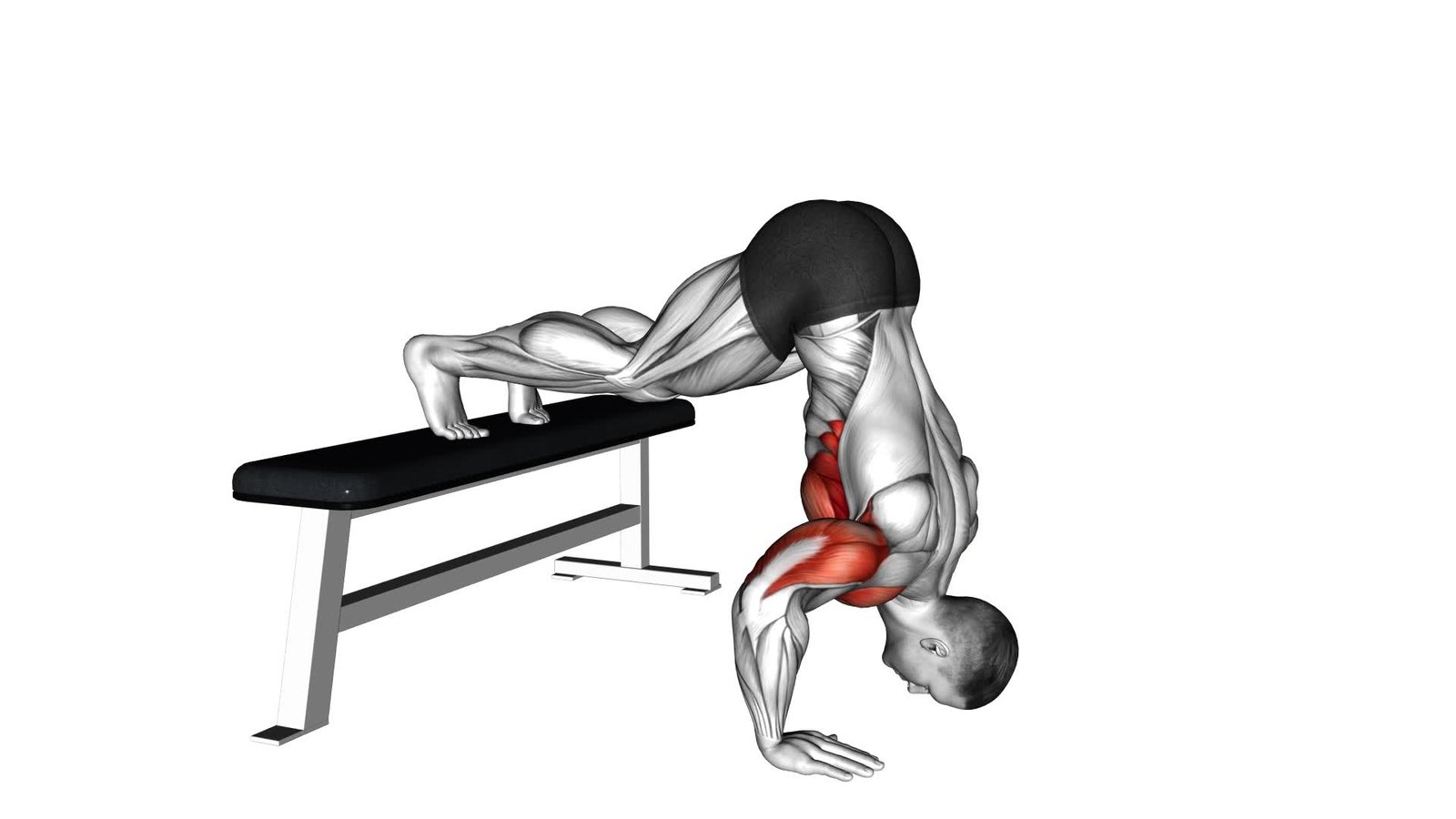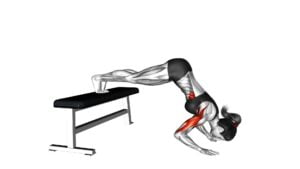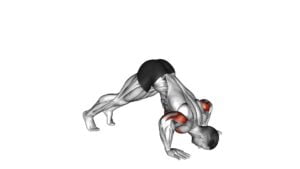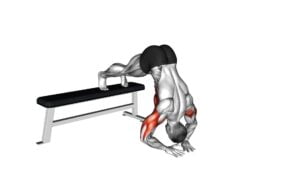Pike Push-up (on Bench) (VERSION 2) – Video Exercise Guide & Tips

Get ready to take your push-up game to the next level with the Pike Push-up (on Bench) (Version 2). This video exercise guide will show you the proper form and technique to maximize your results.
Watch This Exercise Video
Avoid common mistakes and learn tips to increase the intensity of your workout. Whether you're a beginner or advanced user, modifications are available.
Get ready to sculpt and strengthen your upper body with this challenging variation of the push-up.
Key Takeaways
- Pike push-ups on a bench target the shoulders, triceps, and core muscles.
- They improve upper body strength, stability, and overall fitness.
- Pike push-ups on a bench help build strong and well-defined shoulders.
- They enhance posture by strengthening the upper back and neck muscles.
Benefits of Pike Push-up (on Bench) (Version 2)
Discover the numerous benefits you can experience from performing Pike Push-ups (on Bench) (Version 2).
Pike push-ups are a highly effective exercise that target your shoulders, triceps, and core muscles. By engaging these muscle groups, you can improve upper body strength, stability, and overall fitness.
One of the key benefits of Pike Push-ups is that they help to build strong and well-defined shoulders. Additionally, they can help to improve your posture by strengthening the muscles in your upper back and neck.
Performing Pike Push-ups (on Bench) (Version 2) also offers the advantage of being a compound exercise, which means it works multiple muscle groups simultaneously. This can help to increase the efficiency of your workouts and save you time.
It is important to note some common mistakes and modifications that can be made to ensure proper form and technique. Some common mistakes include allowing your lower back to sag or your elbows to flare out to the sides. To modify Pike Push-ups, you can start by performing them on an elevated surface, such as a bench or step, to decrease the intensity.
In the subsequent section, we'll discuss the proper form and technique for performing Pike Push-ups (on Bench) (Version 2), so you can maximize the benefits and minimize the risk of injury.
Proper Form and Technique for Pike Push-up (on Bench) (Version 2)
To perform the Pike Push-up (on Bench) (Version 2) with proper form and technique, it's important to consider hand placement variations, avoid common mistakes, and understand the benefits of this exercise.
Experiment with different hand positions to target different areas of the shoulders and triceps. Be sure to maintain a straight line from your head to your hips throughout the movement and avoid arching your back or sagging your hips.
Hand Placement Variations
Start by placing your hands on the bench in a position that feels comfortable and allows for proper form and technique during the Pike Push-up (on Bench) (Version 2). Hand placement variations can help target different muscle groups and increase the difficulty of the exercise.
To target the shoulders and upper chest, place your hands slightly wider than shoulder-width apart. This wider hand placement will also engage the triceps more.
If you want to focus more on the triceps, bring your hands closer together, forming a diamond shape with your thumbs and index fingers. This narrower hand placement will increase the intensity on the triceps.
Experiment with different hand placements to find what works best for you. Remember to maintain a straight line from your head to your heels throughout the exercise.
Now, let's move on to common mistakes to avoid for the Pike Push-up (on Bench) (Version 2).
Common Mistakes to Avoid
To ensure proper form and technique for the Pike Push-up (on Bench) (Version 2), it's important to be aware of common mistakes that should be avoided. Here are some common mistakes to watch out for:
- Improper hand placement: Make sure your hands are shoulder-width apart and aligned with your shoulders. This will help maintain stability and prevent strain on your wrists.
- Rounded back: Keep your back straight and engage your core throughout the exercise. Avoid arching or rounding your back, as this can lead to poor form and potential injury.
- Lack of control: Slowly lower yourself down and push back up in a controlled manner. Avoid rushing through the movement, as this can compromise your form and limit the effectiveness of the exercise.
- Poor head positioning: Look slightly forward, rather than tucking your chin or looking straight down. This will help align your spine and maintain proper form throughout the exercise.
Benefits of Pike Push-Ups
Get ready to experience the numerous benefits of performing Pike Push-Ups with proper form and technique. Pike Push-Ups are a highly effective exercise that targets the shoulders, triceps, and upper back muscles. By engaging these muscles, you can improve your upper body strength and stability.
Additionally, Pike Push-Ups help to increase shoulder mobility and flexibility, which can be beneficial for various activities and sports.
For beginners, modifications can be made to make the exercise more manageable. You can start by performing Pike Push-Ups with your hands on an elevated surface, such as a bench, to decrease the intensity. As you become more advanced, you can increase the difficulty by elevating your feet or using a stability ball. These modifications allow you to gradually progress and challenge yourself.
Remember to maintain proper form and technique throughout the exercise to maximize the benefits and prevent injury.
Common Mistakes to Avoid During Pike Push-Up (On Bench) (Version 2)
Avoid making the mistake of placing your hands too close together during the Pike Push-Up (On Bench) (Version 2). This common mistake can lead to improper form and reduced effectiveness of the exercise.
To ensure you're performing the Pike Push-Up correctly, keep the following points in mind:
- Hand Placement: Position your hands slightly wider than shoulder-width apart on the bench. This allows for proper alignment and stability throughout the movement.
- Elbow Position: Keep your elbows pointed outwards, away from your body, as you lower yourself towards the bench. This engages the muscles of your shoulders and upper back more effectively.
- Head Position: Maintain a neutral position with your head and neck. Avoid tucking your chin in or looking upwards, as this can strain your neck and affect your overall form.
- Full Range of Motion: Aim to lower your body until your head is just above the bench, and then press back up to the starting position. Avoid cutting the range of motion short, as this limits the benefits of the exercise.
By following these proper technique guidelines, you can maximize the effectiveness of the Pike Push-Up (On Bench) (Version 2).
Now, let's move on to discuss some tips to increase the intensity of this exercise and challenge your muscles further.
Tips to Increase the Intensity of Pike Push-up (on Bench) (Version 2)
To increase the intensity of your Pike Push-up (on Bench) (Version 2), there are several tips you can follow.
First, try different hand placements to target different muscle groups and challenge yourself.
You can also add resistance bands to increase the resistance and make the exercise more challenging.
Lastly, elevate your feet on a platform or bench to further engage your shoulders and upper body.
Hand Placement Variations
Place your hands slightly wider than shoulder-width apart and slightly turned outwards to increase the intensity of the Pike Push-up (on Bench) (Version 2). This variation in hand positioning and finger placement targets different muscle groups, providing a more challenging workout.
Here are four hand placement variations to enhance the effectiveness of the exercise:
- Wide Grip: Position your hands wider than shoulder-width apart. This increases the load on your shoulders and chest, engaging more muscles.
- Narrow Grip: Bring your hands closer together, slightly narrower than shoulder-width apart. This places greater emphasis on your triceps and helps improve overall upper body strength.
- Fingertip Push-ups: Instead of placing your palms flat on the bench, perform the push-up on your fingertips. This enhances wrist and forearm strength while also increasing the difficulty of the exercise.
- Diamond Grip: Form a diamond shape with your hands, placing your thumbs and index fingers together. This targets your triceps, chest, and shoulders, providing a challenging variation to the standard push-up.
Experiment with these hand placement variations to add variety and intensity to your Pike Push-up routine. Remember to maintain proper form and listen to your body to avoid injury.
Adding Resistance Bands
To increase the intensity of the Pike Push-up (on Bench) (Version 2), you can incorporate resistance bands for added challenge and muscle engagement. Adding resistance bands modifies the exercise by increasing the load on your upper body muscles, particularly the shoulders and triceps.
Start by securing the resistance bands around the bench, making sure they're taut but not too tight. Position yourself in the pike push-up position on the bench, with your hands on the edge and your feet on the ground.
As you lower your body towards the bench, the resistance bands will provide additional resistance, making it more challenging to push back up. This added resistance will help to further strengthen and tone your upper body muscles.
Remember to maintain proper form and control throughout the exercise to maximize its effectiveness.
Elevating the Feet
Increase the intensity of your Pike Push-up (on Bench) (Version 2) by elevating your feet, which will challenge your upper body muscles even further. Elevating the feet during the Pike Push-up (on Bench) (Version 2) exercise can be done by placing your feet on a stable elevated surface such as a bench or step.
Here are some tips to help you maximize the benefits of elevating your feet:
- Start with a lower surface elevation and gradually progress to higher elevations to increase the difficulty.
- Ensure that your body forms a straight line from your head to your heels throughout the exercise.
- Engage your core and maintain stability by squeezing your glutes and bracing your abs.
- If elevating your feet is too challenging, you can regress the exercise by placing your feet on the floor instead.
Modifications for Pike Push-up (on Bench) (Version 2) for Beginners or Advanced Users
Try out different variations of the Pike Push-up (on Bench) (Version 2) to challenge yourself at any fitness level. Whether you're a beginner or an advanced user, there are modifications you can make to customize this exercise to your needs.
For beginners, you can start by performing the Pike Push-up (on Bench) (Version 2) with your hands on an elevated surface, such as a bench or step. This modification reduces the amount of weight you have to push, making it more manageable for those just starting out.
As you progress and become more comfortable with the exercise, you can increase the difficulty by elevating your feet on a higher surface or using a stability ball. This will engage your shoulder muscles even more and provide a greater challenge.
For advanced users, you can further intensify the exercise by adding resistance bands or using dumbbells to increase the load. These modifications will help you continue to build strength and develop your shoulder muscles.
Now that you have learned about the modifications for the Pike Push-up (on Bench) (Version 2), let's explore a sample workout routine that incorporates this exercise.
Sample Workout Routine Incorporating Pike Push-up (on Bench) (Version 2)
Now let's incorporate the Pike Push-up (on Bench) (Version 2) into a sample workout routine to maximize your shoulder muscle development. Here is a precise and informative workout routine that includes advanced techniques and workout modifications:
- Warm-up: Begin with five minutes of light cardio, such as jogging or jumping jacks, to increase your heart rate and prepare your muscles for the workout.
- Pike Push-up (on Bench) (Version 2): Perform three sets of 8-10 reps of Pike Push-ups on a bench. This exercise targets your shoulders, triceps, and upper chest, helping to build strength and definition.
- Superset: After completing the Pike Push-ups, immediately move on to a superset of dumbbell lateral raises and overhead presses. Perform three sets of 12-15 reps for each exercise, alternating between them without rest. This superset will further target and exhaust your shoulder muscles.
- Cool-down: Finish your workout with five minutes of stretching exercises to promote flexibility and prevent muscle soreness.
Frequently Asked Questions
Can I Do Pike Push-Ups on a Regular Bench or Do I Need a Specific Type of Bench?
You can definitely do pike push-ups on a regular bench, no need for a specific type of bench.
Pike push-ups on an adjustable bench offer several benefits. They target your shoulders, triceps, and upper chest, improving your upper body strength and stability.
Are Pike Push-Ups on the Bench Suitable for People With Shoulder or Neck Injuries?
Pike push-ups on the bench may not be suitable for people with shoulder or neck injuries. It's important to prioritize safety and avoid further aggravating your injury. Instead, consider modifications for shoulder injuries, such as using a stability ball or doing wall push-ups.
For neck injuries, alternative exercises like seated dumbbell presses or resistance band shoulder exercises may be more appropriate.
Always consult with a healthcare professional before attempting any new exercises.
How Many Repetitions and Sets Should I Do When Incorporating Pike Push-Ups on the Bench Into My Workout Routine?
When incorporating pike push-ups on the bench into your workout routine, it's important to consider repetition and set recommendations.
The number of repetitions and sets can vary depending on your fitness level and goals. It's generally recommended to start with 3-4 sets of 8-12 repetitions. However, you can adjust this based on your own abilities and progress over time.
Remember to listen to your body and gradually increase the intensity as you become stronger and more comfortable with the exercise.
Can Pike Push-Ups on the Bench Help Improve My Handstand Push-Up Strength?
Yes, pike push-ups on the bench can definitely help improve your handstand push-up strength. Pike push-ups are an effective exercise that target your shoulders, triceps, and upper chest muscles. By incorporating different pike push-up variations into your workout routine, you can build strength and stability in your upper body, which will directly translate to improved handstand push-up performance.
The benefits of pike push-ups extend beyond just the handstand push-up, as they also improve shoulder and core strength.
Are Pike Push-Ups on the Bench More Challenging Than Regular Push-Ups for Beginners?
Pike push-ups on the bench can be more challenging than regular push-ups for beginners. This is because the pike push-up form requires a higher level of upper body strength and stability. By elevating your feet on a bench, you increase the angle of your body, intensifying the load on your shoulders, chest, and triceps.
This can help beginners build strength and improve their overall push-up performance. Additionally, pike push-ups on the bench provide the added benefit of engaging your core muscles for stability.
Conclusion
In conclusion, the Pike Push-up (on Bench) (Version 2) is a beneficial exercise for strengthening the upper body and improving shoulder stability. By maintaining proper form and avoiding common mistakes, individuals can maximize the effectiveness of this exercise.
Increasing the intensity can be achieved through various tips, while modifications cater to beginners and advanced users.
Incorporating the Pike Push-up (on Bench) (Version 2) into a workout routine can help individuals achieve their fitness goals.

Author
Years ago, the spark of my life’s passion ignited in my mind the moment I stepped into the local gym for the first time. The inaugural bead of perspiration, the initial endeavor, the very first surge of endorphins, and a sense of pride that washed over me post-workout marked the beginning of my deep-seated interest in strength sports, fitness, and sports nutrition. This very curiosity blossomed rapidly into a profound fascination, propelling me to earn a Master’s degree in Physical Education from the Academy of Physical Education in Krakow, followed by a Sports Manager diploma from the Jagiellonian University. My journey of growth led me to gain more specialized qualifications, such as being a certified personal trainer with a focus on sports dietetics, a lifeguard, and an instructor for wellness and corrective gymnastics. Theoretical knowledge paired seamlessly with practical experience, reinforcing my belief that the transformation of individuals under my guidance was also a reflection of my personal growth. This belief holds true even today. Each day, I strive to push the boundaries and explore new realms. These realms gently elevate me to greater heights. The unique combination of passion for my field and the continuous quest for growth fuels my drive to break new ground.



